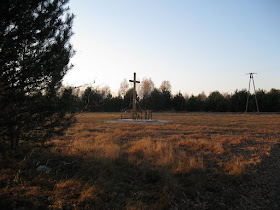This is Gravel Road (ul Żwirowa), which, according to my mobile phone map, is a built-up area.
 |
| From 2011 11 |
The road leading off to the left is Torquoise street, a model of urban tranquillity.

The other side of the road being no less an escape from urban life.

Fox Road (ul Lisia) is the southern end of the built-up area (to the left), whilst the forest is on the right. Fox Road provides an east/west back road from Rusiec, but it is virtually impassable for normal cars.

The built up area on the map ends at Radar Road, with the left side of this picture being outside it.

There are some houses already built in the non-urban section, however.

This cross immediately over the other side of the road, marks the planned site for a new church: currently open country.

The stone chip surface is new and was presumably laid for the church - other busier roads are just compacted earth. Not many people live there, from the view south further up the road.

Looking north.

It's hard to tell where the side roads are along much of Radar Road, so I turned back along the first clear track. Even this was closed by a branch railing to stop cars. I think it it is Amethyst Street (Bursztynowa), which at the Radar end is still undeveloped. The houses start further to the west.

I think this is the northern end of Gravel Road. Quite a lot of houses have been built in this part.

Even so, there are wide open spaces. Amethyst Street doesn't appear on the map. The yellow sign in the distance shows a building plot for sale. There are many such signs all over the area.

There are also houses for sale. In this case, however, the plot is said to be for sale rather than the half-built shack. I would guess it was originally intended as a summer house in the country for a city dweller.
I have this pet theory that one of the reasons that Poland is statistically a poorer country than places like the UK is simply the easy availability of building land. The UK's paucity of space creates premium disposable wealth in buildings and property, with major multiplier effects throughout the domestic economy eg the need for high incomes to pay for housing. Paradoxically, the ready availability of space provides better, more spacious living conditions in Poland, whilst having a far lower multiplier effect. People have a better quality of life even though they are poorer. Imagine what all these plots of land would be worth if they were an hour's drive from London rather than Warsaw.
Returning home along the southern main road of Rusiec - Estate or Settlement Road (Osiedlowa), I passed the rather strange collection of buildings that seem to be the oldest, still inhabited dwellings in the area. They are poor people in Poland, although they seem to have a large area of land. They grow vegetables in the empty space beside the house, so I think it is their property. I would guess that it could hold eight to ten new houses, which in England might each be worth half a million pounds or so. The land itself might therefore be worth half a million in England. It is probably unsellable in Poland except at a rock bottom price: it just has an unforcastably long-term investment value.

Finally back home, we have our own view of Rusiec.

No comments:
Post a Comment